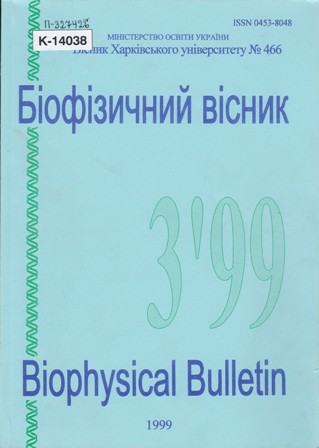СВОЙСТВА РАСТВОРА ГЛИЦИНА В ИНТЕРВАЛЕ ТЕМПЕРАТУР 20°-70°С ПО ДАННЫМ СВЧ-ДИЭЛЕКТРОМЕТРИИ И ВИСКОЗИМЕТРИИ
Abstract
Проведено исследование изменения вязкости и времени релаксации 20% раствора глицина в интервале температур 20-70°С. Методика измерения вязкости описывается. Приводятся данные расчета статической проницаемости и времени релаксации по модели Дебая, учитывающей среднее время релаксации в растворе. Обсуждается отличие рассчитанных величин от значений, измеренных альтернативными методами. Предлагается возможный механизм, объясняющий изменение параметров в диапазоне температур.
КЛЮЧЕВЫЕ СЛОВА: глицин, время релаксации, диэлектрическая проницаемость, водные растворы.
Downloads
References
2. Ахадов Я.Ю. Диэлектрические свойства бинарных растворов. М., Наука, 1977, 400 с.
3. Оствальд В., Лютер Р., Друкер Д. Физико-химические измерения. Л. Госхимтехиздат, 1934, ч.1„ 279 с.
4. Дебай П., Полярные молекулы. ГТТИ, 1931, 240 с.
5. Глибицкий Г.М. // Біофіз. вісник. 1999, N4, с.31-34.
6. Глибицкий Г.М. // Радиофизика и электроника. 1997. Т. 2. № 2, с. 156-159.
7. Grant Е.Н. Sheppard R.J., South G.P. Dielectric bihavior of biological molecules in solution. Oxford, Claredon press 1978.
8. Зульфугурзаде К.Э., Мирзоев Ф.Г., Иманов Л.М. // Изв. АН Азерб. ССР. 1979, № 4, с. 111-114.
Authors who publish with this journal agree to the following terms:
- Authors retain copyright and grant the journal right of first publication with the work simultaneously licensed under a Creative Commons Attribution License that allows others to share the work with an acknowledgement of the work's authorship and initial publication in this journal.
- Authors are able to enter into separate, additional contractual arrangements for the non-exclusive distribution of the journal's published version of the work (e.g., post it to an institutional repository or publish it in a book), with an acknowledgement of its initial publication in this journal.
- Authors are permitted and encouraged to post their work online (e.g., in institutional repositories or on their website) prior to and during the submission process, as it can lead to productive exchanges, as well as earlier and greater citation of published work (See The Effect of Open Access).





